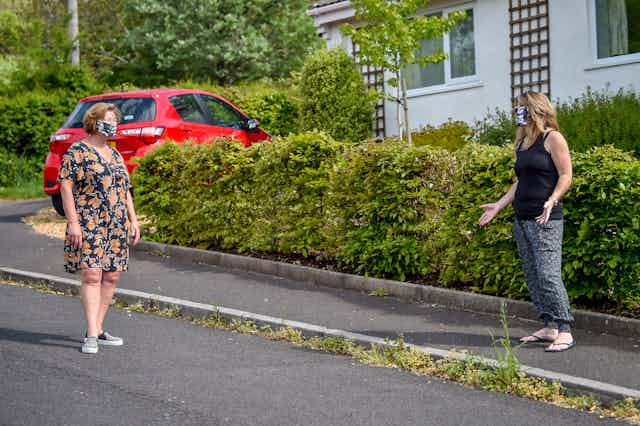Across Europe, schools are opening, cars are back on the roads and people are returning to their daily commutes on public transport. Lockdowns are easing, if not ending. The hope now is that many countries are moving past the first wave of the coronavirus pandemic.
The UK seems ready to follow suit, with its five-step plan to ease lockdown. The end of the strictest measures comes just in time – the country is set to see its worst economic downturn since 1706, as almost all business activities have been put on hold.
So the UK plans to ease the lockdown are highly welcome. Yet, they do not mean a return to pre-pandemic normality. Easing the lockdown will mean people gradually getting more freedom to engage in social and economic activities, but also that they must take good care to keep a safe distance from others. And with the extra freedom comes risk as people suddenly get more opportunities to get close to others.
Effective mitigation relies on people’s individual decisions to comply with social distancing measures. We have already seen images of packed trains and tubes as the easing of the lockdown started in England.

To deal with this risk, UK Prime Minister Boris Johnson’s plan introduces higher fines for those caught violating social distancing measures. Fines will be £100 for each first offence and double to a maximum of £3,200 pounds for repeat offenders. This approach is rooted in the centuries-old idea of deterrence, under which people are less likely to break rules out of fear of punishment.
So will this work? Will people heed the government’s call to stay alert, control the virus and save lives, by following social distancing rules?
Why we comply with lockdown measures
To answer this question we must look at why people have been complying with the lock down measures so far. We conducted a behavioural survey in a nationally representative sample in the UK in early April, which has been published as a preprint. With the survey, we assessed why people were or were not complying with lockdown measures.
The survey used a standard social science approach to study compliance and rule-violating behaviour. We first asked participants to report how often they kept a safe distance from people outside of their own household, whether they went outside for nonessential activities, and whether they met friends and family.
After that, we asked our participants to answer a range of questions about factors that we thought could influence their behaviour. For instance whether they were afraid of the disease, whether they supported the measures, whether they were able to follow the measures, and whether they were afraid to get caught and punished should they violate the rules.
We then used a statistical form of analysis – an ordinary least squares (OLS) regression – to find out whether these factors could explain variation in people’s compliance. Such analysis allows us to understand which of the variables had a significant impact on whether people followed the rules.
The data show that in early April, most UK citizens we interviewed reported they were complying with the rules.

But our survey nonetheless shows the risk of the approach taken to ease the lockdown. We found that compliance was higher when people were practically able to follow the measures and could work from home and stay away from others. On the other hand, we found that there was a significant relationship between people’s opportunity to meet people outside of their own household and their likelihood of violating the social distancing measures.
So the more freedom people have to socialise, the more likely they will do so. Before easing the lockdown, people had very limited freedom to meet friends and family and that kept them safely apart. Now they get that freedom, it is vital to ensure they socialise at a safe distance.
Why fines won’t work
Our survey also looked at whether the threat of higher sanctions might help to ensure compliance with the mitigation measures. Unfortunately, we did not find a significant association between people’s fear of punishment and compliance.
Decades of social science research about the effect of punishment on criminal behaviour have not shown conclusive evidence that punishment works as an effective deterrent.
Such research shows that for deterrence to work, the severity of the punishment does not matter much. The most important aspect is whether people think they will get caught. And catching violators of social distancing rules will be extra hard in an opening society, as there are so many more people mingling. In light of all this, the higher fines are unlikely to have much effect in ensuring social distancing.
Our survey did show that people’s intrinsic motivation played an important role in their compliance. If people felt a greater general duty to obey the law, they were more likely to comply. So it is crucial that authorities do all they can to maintain such sense of civic obedience.
There is a vital link with law enforcement here. Police must be very careful in enforcing the measures and applying the authority to issue fines. Decades of research has shown that when people see unfair law enforcement they develop a negative view of the legal system that undermines their sense of duty to obey its rules.
We all wish we could return to normal. The easing of restrictions in the UK is hopeful, it shows us a path to economic recovery and social healing. But it is a path filled with extra behavioural challenges and risks. If we fail to rely on behavioural science insights and data on how we can keep up social distancing, this disease can all too easily make a comeback.

